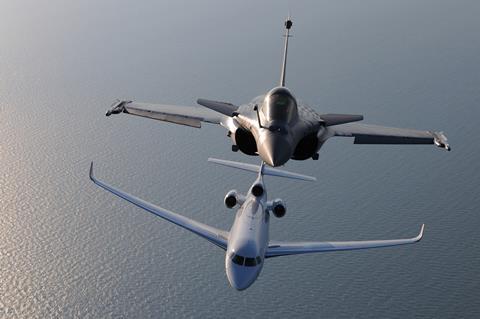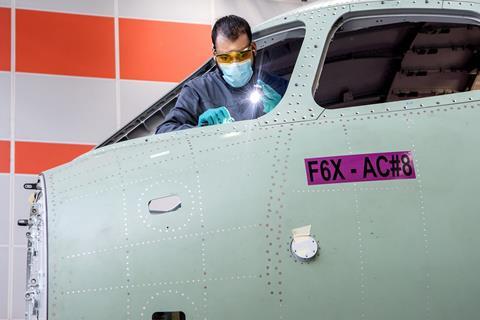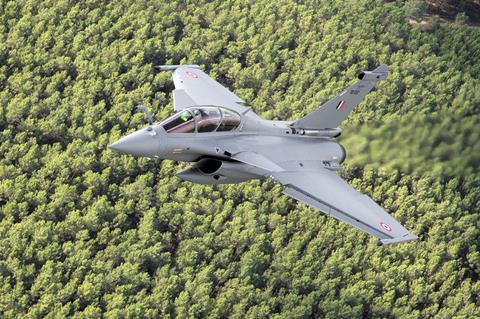In any normal year, Dassault’s operations represent a delicate balancing act: between the very different markets of business and military aviation; and within the latter, between domestic and export orders for the Rafale fighter.
Usually everything can be kept in some sort of equilibrium; production and deliveries of Falcon jets are flexed up or down to suit the changing market, while output of the Rafale tends towards the predictable.

However, as the coronavirus pandemic rips through the aerospace industry, maintaining its poise is now more complicated than ever for Dassault.
Instead of simply balancing those issues above, the French manufacturer must also consider the tension brought by a reeling – in some cases failing – supply chain, an inability to conclude export orders, an uncertain outlook for business jets in the short term, and all the while maintaining elevated levels of research and development spending.
In fact, if Dassault’s business typically resembles a tightrope walk, this year it appears to be doing that blindfolded.
Take the market for its Falcon business jets. At the half-year point, orders and deliveries were roughly on a par with the same period a year earlier: five against seven, and 16 versus 17, respectively. Its backlog stands at 42 aircraft, down from 53 at the end of 2019.
But faced with a production system disrupted by Covid-19, which included the closure of its Merignac plant for nearly a month in March and April, plus a degree of customer uncertainty, the airframer has taken the decision to reduce delivery guidance this year from 40 to 30.
This revised target, says chief executive Eric Trappier, “is tenable”, with the 10-unit balance pushed into 2021.
On the positive side, customers have yet to axe any orders, Trappier said during a press conference on 23 July. “I am not saying that we won’t have any, but in the first half we did not have any – but there have been some postponements of deliveries.”

Despite the uncertain outlook, Dassault is pushing ahead with two new business aircraft: the 6X, which will fly in 2021 and enter service the following year, and the Future Falcon programme the company is now referring to as the “NX”.
With work under way on the pair, the airframer is investing more in both absolute and relative terms: during the first half, self-funded R&D stood at €262 million ($307 million), or 9.9% of net sales, against figures of €258 million and 8.4% in the first six months of 2019.
But all the while R&D investment is rising, net sales are headed in the other direction: during the first half, they slid to €2.6 billion, down from €3.1 billion in the same period a year earlier. It is also certain they will not reach 2019’s 12-month figure of €7.3 billion.
Justifying the increase, Trappier notes that “when we exit this crisis… [customers] will need aircraft and we will be around to provide them”, even though this will “cost some of our margin”.
But previous development problems are also responsible for this R&D “peak”: Dassault’s 5X ultra-wide-cabin jet was due to have been in service by 2017, leaving just the Falcon NX on its drawing board. Instead, the former was cancelled in December 2017 and eventually replaced by the 6X, pushing the timeline to the right. Therefore expenditure will remain at this elevated level until at least 2022, when the new jet enters service.
In the military segment, meanwhile, Dassault continues production of the Rafale fighter for India and Qatar: all 13 aircraft to be built this year – half of 2019’s total – are destined for export, although the company does not detail the balance between the two customers. Of the 68-unit Rafale backlog at 30 June, 40 aircraft, worth a combined €9.5 billion, were for export.
Although the overall figures are complicated by the fact that Dassault recognises the value of export contracts in their entirety – including the share due to respective engine and systems suppliers Safran and Thales – those orders still account for almost 60% of the total backlog value, followed by France (€4.7 billion/29%) and Falcons (€2 billion/12.3%).

Domestic deliveries are due to resume in 2022 as France begins receiving the 28 Rafales still outstanding from a 180-aircraft, four-batch total. In the meantime, negotiations with Paris regarding a fifth lot of fighters, “dating from before the health crisis”, have resumed. While that additional purchase was flagged in 2018 in France’s most recent military procurement plan, Trappier is hopeful that it will now go “slightly further” as part of the government’s aerospace rescue efforts.
But Trappier notes that for Dassault’s “economic model” to work, “export contracts” are required alongside those from its home nation. Unfortunately, Covid-19 has delayed these sales: “While the phone did work [in the first half], countries were mobilising against their fight against the virus,” he says, while other prospective customers have suffered “economic consequences” from the pandemic.
Paris does have an additional incentive to purchase the Rafale, argues Trappier, as such orders serve as an “economic stabliser” for both the company and the wider supply chain.
The network of small and medium-sized businesses in France feeding the industry powerhouses – Airbus, Dassault, Safran and Thales – has been hard hit by an exposure to the rapid contraction of commercial aerospace, what Trappier calls the “Airbus effect”.
He remains hopeful that the French government’s rescue plan for the sector – which will see a €400 million investment fund established jointly with industry, including a €13 million contribution from Dassault – will help overcome the short-term stresses and enable the supply chain to emerge “stronger than it was before” and become “more modern and upgraded”.
Although that could include funding to aid consolidation, it also encompasses investment in the digital processes and systems which, he says, enabled Dassault to continue its “activity during the crisis”.
But while technology can get you so far, it is clear that Dassault’s business still relies on human contact: the official launch of the NX programme, due in the first quarter, was postponed as customers were unable to travel to any event “and contribute to the announcement”.


























